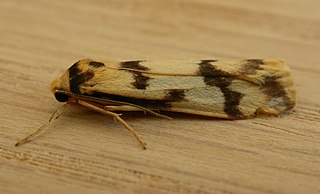
Tigrioides is a genus of moths in the family Erebidae. The genus was erected by Arthur Gardiner Butler in 1877.
Manulea minima is a moth of the family Erebidae. It is found in China.
Proschaliphora minima is a moth in the subfamily Arctiinae. It was described by Lars Kühne in 2010. It is found in Namibia.
Pseudocharis minima, the lesser wasp moth, is a moth in the subfamily Arctiinae. It was described by Augustus Radcliffe Grote in 1867. It is found on Cuba and in Florida. The habitat consists of pine rocklands, tropical hammocks and the ecotone between hammocks and salt marshes.
Tigrioides antipulvereola is a moth in the family Erebidae. It was described by Jeremy Daniel Holloway in 2001. It is found on Borneo. The habitat consists of lower montane forests and lowland forests.
Tigrioides chionostola is a moth in the family Erebidae. It was described by George Hampson in 1918. It is found on New Guinea.

Tigrioides dimidiata is a moth in the family Erebidae. It was described by Shōnen Matsumura in 1927. It is found in Taiwan.
Tigrioides euscia is a moth in the family Erebidae. It was described by George Hampson in 1914. It is found on New Guinea, where it is only known from the Star Mountains in Papua New Guinea.
Tigrioides fulveola is a moth in the family Erebidae. It was described by George Hampson in 1900. It is found in Kolkata and Sikkim in India.
Tigrioides grisescens is a moth in the family Erebidae. It was described by George Thomas Bethune-Baker in 1908. It is found in New Guinea, where it is found in Papua New Guinea and the Central Mountain Range in Papua.
Tigrioides leucanioides is a moth in the family Erebidae. It was described by Francis Walker in 1862. It is found in southern Myanmar and on Peninsular Malaysia, Sumatra and Borneo. The habitat consists of lower montane forests and lowland forests, including alluvial forests.
Tigrioides nitens is a moth in the family Erebidae. It was described by Francis Walker in 1865. It is found in Australia, where it has been recorded from New South Wales, the Northern Territory and Queensland.
Tigrioides phaeola is a moth in the family Erebidae. It was described by George Hampson in 1900. It is found in Sri Lanka and India (Mumbai).
Tigrioides sabulosalis is a moth in the family Erebidae. It was described by Francis Walker in 1866. It is found in India, Sri Lanka, Myanmar and on Peninsular Malaysia, Sumatra and Borneo.
Tigrioides inversa is a moth in the family Erebidae. It was described by Max Gaede in 1925. It is found in New Guinea, where it is found in Papua New Guinea and Papua.
Tigrioides schraderi is a moth in the family Erebidae. It was described by Max Gaede in 1925. It is found in New Guinea, where it is found in Papua New Guinea and the Pass Valley in the Jayawijaya Mountains in Papua.
Tigrioides luzonensis is a moth in the family Erebidae. It was described by Schaus in 1922. It is found in the Philippines.
Tigrioides pallidicosta is a moth in the family Erebidae. It was described by Schaus in 1922.
Tigrioides pyralina is a moth in the family Erebidae. It was described by Rothschild in 1912. It is found on Sumbawa.
Tigrioides soror is a moth in the family Erebidae. It was described by Schaus in 1922. It is found on Java.

